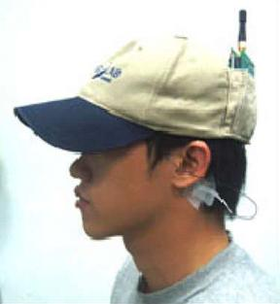A baseball cap that reads your mind

It looks like an ordinary baseball cap. But when you put it on, the cap detects and analyzes the electroencephalogram (EEG) signals from your brain. It can even tell you if you’re getting too sleepy when driving based on your brain wave patterns. Similar technology could also allow you to control home electronics such as TVs, computers, and air conditioners, all by just thinking about them.
A team of researchers from Taiwan has designed the new bio-signal monitoring system inside a baseball cap with the goal of making it convenient and easy to use in everyday life. Since the system is wireless and portable, and can process data and provide feedback in real time, it could be useful for a variety of indoor and outdoor applications.
“This study details the design, development and testing of a non-invasive mobile and wireless EEG system for continuously monitoring high-temporal resolution brain dynamics without requiring conductive gels applied to the scalp,” researcher Li-Wei Ko from National Chiao-Tung University in Taiwan told PhysOrg.com. “This system has online EEG signal acquisition and real-time signal processing. It can be used in many applications; we just applied it to driving tasks in this work, such as drowsiness.”
Along with Ko, researchers from the National Chiao-Tung University, National Cheng-Kung University, and the University of California, San Diego, have published their study on the brain-computer interface (BCI) system in a recent issue of IEEE Transactions on Biomedical Engineering.
As the researchers explain, by measuring EEG signals, the BCI system can monitor an individual’s physiological and cognitive states. The system takes advantage of advances in sensor and information technology to achieve reduced power consumption and production costs. Currently, the system can operate continuously for about two days before the lithium-ion battery needs to be recharged, but the researchers hope to further increase the lifetime.
The cap contains five embedded dry electrodes on the wearer’s forehead, and one electrode behind the left ear, that acquire EEG signals. Then, the EEG signals are wirelessly transmitted to a data receiver, where they are processed in real-time by a dual-core processor. The BCI system includes Bluetooth transmission for distances of 10m or less (e.g., for driving applications), as well as RF transmission for distances up to 600m (e.g., for potential sports applications). Next, the processed signals are transmitted back to the cap, where the data can be stored, displayed in real-time on a screen, or be used to trigger an audio warning, if necessary.
For instance, to test the accuracy of the real-time driver’s drowsiness warning system, the researchers performed experiments with subjects in a virtual reality highway-driving environment. Subjects “drove” a real car mounted on a 6-degree-of-freedom platform, with three-dimensional surrounding screens. The car randomly drifted away from the center of the lane, and drivers had to correct the deviation. The longer it took to correct (and the slower the response time), the more drowsy the driver.
Drivers also wore the BCI cap, which detected their EEG signals while they drove so that the researchers could compare the BCI system’s drowsiness calculations with the drowsiness level as determined by the virtual reality system. The average correlation of the two measurements was 75%, suggesting that the BCI system closely determined the users’ drowsiness levels.
Besides driving, mobile EEG-sensing BCI systems could be used for a variety of other applications. For medical purposes, the researchers suggest that the technology could be used for home care for the elderly, medical monitoring, and exercise training. They also expect it to have applications in controlling household electronics devices, which has previously been investigated for physically disabled individuals.
“We will miniaturize the system and apply SoC [system on chip] technology,” Ko said. “We also will create more applications using the mobile and wireless EEG system.”
More information: Lin, Chin-Teng; Chen, Yu-Chieh; Huang, Teng-Yi; Chiu-Tien-Ting; Ko, Li-Wei; Liang, Sheng-Fu; Hsieh, Hung-Yi; Hsu, Shang-Hwa; Duann, Jeng-Ren. “Development of Wireless Brain Computer Interface With Embedded Multitask Scheduling and its Application on Real-Time Driver’s Drowsiness Detection and Warning.” IEEE Transactions on Biomedical Engineering, Vol. 55, No. 5, May 2008.
Copyright 2008 PhysOrg.com.
All rights reserved. This material may not be published, broadcast, rewritten or redistributed in whole or part without the express written permission of PhysOrg.com.





















